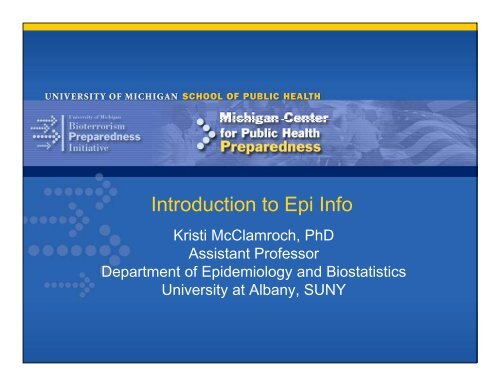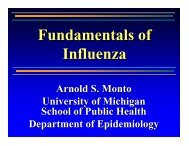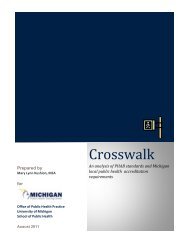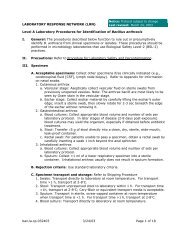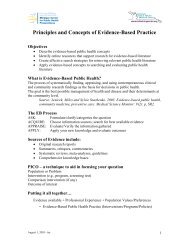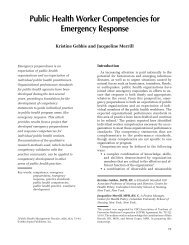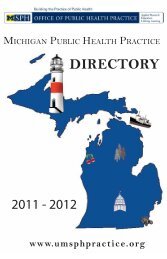Introduction to Epi Info - Office of Public Health Practice
Introduction to Epi Info - Office of Public Health Practice
Introduction to Epi Info - Office of Public Health Practice
You also want an ePaper? Increase the reach of your titles
YUMPU automatically turns print PDFs into web optimized ePapers that Google loves.
<strong>Introduction</strong> <strong>to</strong> <strong>Epi</strong> <strong>Info</strong><br />
Kristi McClamroch, PhD<br />
Assistant Pr<strong>of</strong>essor<br />
Department <strong>of</strong> <strong>Epi</strong>demiology and Biostatistics<br />
University at Albany, SUNY
Overview<br />
• <strong>Introduction</strong>s<br />
• Overview<br />
• Brief His<strong>to</strong>ry <strong>of</strong> <strong>Epi</strong> <strong>Info</strong><br />
• <strong>Epi</strong> <strong>Info</strong> Workshop<br />
• Developing gquestionnaires<br />
• Entering data<br />
• Break<br />
• Analyzing data<br />
• Closing Cos Comments
Brief His<strong>to</strong>ry <strong>of</strong> <strong>Epi</strong> <strong>Info</strong><br />
• From the <strong>Epi</strong> <strong>Info</strong> Museum website, ‘Key Events in the<br />
His<strong>to</strong>ry <strong>of</strong> <strong>Epi</strong> <strong>Info</strong>’, Centers for Disease Control and<br />
Prevention<br />
http://www.cdc.gov/<strong>Epi</strong><strong>Info</strong>/background.htm
1976<br />
• The beginning <strong>of</strong> flexible computing in public<br />
health.<br />
• Audi<strong>to</strong>rium A at CDC, converted <strong>to</strong> a war room for<br />
the Swine Flu crisis, was filled with epidemiologists<br />
and a minicomputer the size <strong>of</strong> a refrigera<strong>to</strong>r.<br />
• A program called SOCRATES, written in<br />
FORTRAN, allowed epidemiologists i i <strong>to</strong> define<br />
questions, enter data, and summarize the results in<br />
tabular form without the aid <strong>of</strong> a programmer.
1978-84<br />
• The <strong>Epi</strong>demiologic Analysis System (EAS), a more<br />
flexible version <strong>of</strong> SOCRATES, was written in<br />
BASIC and set up on a minicomputer for remote<br />
access by the Georgia state t health department.<br />
t<br />
• The Conference (now Council) <strong>of</strong> State and<br />
Terri<strong>to</strong>rial <strong>Epi</strong>demiologists formed a Computer<br />
Working Group, and developed a five-point plan for<br />
development <strong>of</strong> epidemiologic computing.
1984<br />
• Dr. Andrew Dean, Chairman <strong>of</strong> the CSTE<br />
Computer Working Group produced plans<br />
for a series <strong>of</strong> programs called EPI-AID <strong>to</strong><br />
assist epidemiologists in outbreak<br />
investigations.
1985<br />
• Jeffrey A. Dean, a Junior at Paidea High School,<br />
began a field internship in computing at an insurance<br />
company, which required keeping a large printer<br />
supplied with paper.<br />
• He expressed a desire for a more challenging<br />
experience <strong>to</strong> his Dad, who gave him specifications<br />
for a data entry program for epidemiology.
• During March 1985, he wrote ENTER in<br />
Turbo Pascal, the language he had previously<br />
used <strong>to</strong> adapt a mainframe version <strong>of</strong><br />
Dungeons and Dragons <strong>to</strong> a microcomputer.
• Tony Bur<strong>to</strong>n, author <strong>of</strong> the BASIC version <strong>of</strong> the<br />
<strong>Epi</strong>demiologic Analysis System, provided ideas for<br />
the first version <strong>of</strong> ANALYSIS, programmed by Jeff<br />
during the summer <strong>of</strong> 1986.<br />
• Several years later, Tony moved <strong>to</strong> the Global<br />
Programme on AIDS, World <strong>Health</strong> Organization,<br />
Geneva, and he and Jeff continued <strong>to</strong> collaborate on<br />
later versions <strong>of</strong> <strong>Epi</strong> <strong>Info</strong> as Jeff traveled <strong>to</strong> Geneva<br />
during college vacations.
• Dr. Richard Dicker, author <strong>of</strong> the<br />
<strong>Epi</strong>demiology in Action training manual and<br />
coordina<strong>to</strong>r <strong>of</strong> the <strong>Epi</strong>demic Intelligence<br />
Service (EIS) course at CDC, ,provided<br />
advice on the statistics that were included<br />
with <strong>Epi</strong> <strong>Info</strong>.
<strong>Epi</strong> <strong>Info</strong> Version 1<br />
Menu <strong>of</strong> the first version <strong>of</strong> <strong>Epi</strong> <strong>Info</strong><br />
Menu <strong>of</strong> the first version <strong>of</strong> <strong>Epi</strong> <strong>Info</strong>,<br />
implemented as a DOS batch file.
• A 27-page manual was added in February<br />
1986 and the “Programs for Au<strong>to</strong>matic File<br />
Definition, Data Entry, and Tabulation” were<br />
now called <strong>Epi</strong> <strong>Info</strong>. Distribution was<br />
informal; anyone who wanted the programs<br />
was given a pho<strong>to</strong>copy <strong>of</strong> the manual and a 5<br />
1/4 inch floppy diskette.
• The first field trial <strong>of</strong> <strong>Epi</strong> <strong>Info</strong> and its<br />
companion “artificial intelligence” system,<br />
<strong>Epi</strong>aid, was conducted in the investigation <strong>of</strong><br />
a syphilis epidemic in Fort Lauderdale,<br />
Florida, by Dr. Consuelo Beck-Sagué, then<br />
an EIS <strong>Office</strong>r.
• The idea <strong>of</strong> high-level computer assistance in<br />
planning an investigation never caught on,<br />
and the technology <strong>of</strong> the time did not make<br />
the <strong>Epi</strong>aid programs easy <strong>to</strong> use.<br />
• <strong>Epi</strong> <strong>Info</strong>, with its practical <strong>to</strong>ols for<br />
constructing questionnaires and entering and<br />
analyzing data, became ever more popular<br />
over the next few years.
1987<br />
• <strong>Epi</strong> <strong>Info</strong>, Version 2, had a bound manual<br />
<strong>of</strong> 112 pages, a pulldown menu, the EPED<br />
word processor for creating questionnaires,<br />
ENTER, ANALYSIS, an epidemiologic<br />
calcula<strong>to</strong>r called STATCALC, EPICURVE<br />
for plotting his<strong>to</strong>grams, a MERGE program,<br />
and IMPORT and CONVERT programs for<br />
file conversions.
• The TABLES command began <strong>to</strong> <strong>of</strong>fer<br />
statistical output.<br />
• The first versions <strong>of</strong> <strong>Epi</strong> <strong>Info</strong> were<br />
distributed by Andy, Jeff, and Tony from<br />
their <strong>of</strong>fice.<br />
• Suggestions came from users in the field and<br />
were rapidly incorporated in<strong>to</strong> new versions<br />
<strong>of</strong> the s<strong>of</strong>tware.
<strong>Epi</strong> <strong>Info</strong> Versions 2 and 3
1988<br />
• <strong>Epi</strong> <strong>Info</strong>, Version 3, came with a 150-page manual,<br />
enhanced statistics, and sample programs, including two<br />
outbreaks and a surveillance system.<br />
• The programs and manual remained in the public<br />
domain, but copies were also marketed by a commercial<br />
firm in Atlanta without any special arrangement with<br />
CDC.
• This provided a means <strong>of</strong> distribution that<br />
did not require copying by CDC <strong>of</strong>fice staff<br />
or permission <strong>to</strong> distribute through<br />
government channels.
• <strong>Epi</strong> <strong>Info</strong>, Version 4, was developed by<br />
Tony Bur<strong>to</strong>n, who had moved <strong>to</strong> the World<br />
<strong>Health</strong> Organization, Geneva, and by Jeff<br />
Dean, who worked there during summer<br />
vacations.<br />
• It had greatly enhanced features, but also a<br />
number <strong>of</strong> bugs, and was used as the basis<br />
for Version 5, released dfrom CDC.
1990<br />
• <strong>Epi</strong> <strong>Info</strong>, Version 5, featured a manual <strong>of</strong><br />
384 pages, that described missing value<br />
indica<strong>to</strong>rs, linear regression, a variety <strong>of</strong><br />
graphs, analysis <strong>of</strong> matched data, a report<br />
genera<strong>to</strong>r, a relational file system, and<br />
features for nutritional i anthropometry.<br />
• It allowed European date formats and non-<br />
English characters in data fields, and became<br />
the first version <strong>to</strong> be widely distributed<br />
internationally.
• The Turbo Pascal source code was sent <strong>to</strong><br />
volunteer transla<strong>to</strong>rs who recompiled and<br />
distributed the programs in French, Spanish,<br />
and Chinese.<br />
• An Arabic translation was done as a<br />
commercial venture, and the Russian version<br />
was done under contract <strong>to</strong> CDC.
1992<br />
• <strong>Epi</strong> Map, Version 1, was developed by Jeff<br />
Dean and Tony Bur<strong>to</strong>n in Geneva, with<br />
debugging and enhancements by Karl<br />
Brendel at CDC.<br />
• Version 2, developed at CDC, added features<br />
for programming what happens after mouse<br />
clicks on geographic areas.
• <strong>Epi</strong> <strong>Info</strong>, Version 6, had a 600 page<br />
manual, many more programming features,<br />
improved graphics, exact statistics, extensive<br />
examples, a programmable menu system,<br />
and a mini reportable disease surveillance<br />
system for a state health department.
In <strong>Epi</strong> <strong>Info</strong>, Version 6, the questionnaire<br />
allows text <strong>to</strong> define the questions or prompts.<br />
Special symbols like ### and indicate<br />
numeric or Yes/No fields for data entry.
• Robert Fagan, systems analyst at CDC, used<br />
<strong>Epi</strong> <strong>Info</strong> <strong>to</strong> develop reportable disease<br />
s<strong>of</strong>tware eventually used in 42 states and<br />
terri<strong>to</strong>ries in the US.
• Analytic results from Version 6 <strong>of</strong> <strong>Epi</strong> <strong>Info</strong> include<br />
exact confidence limits for the odds ratio and an<br />
explanation <strong>of</strong> the Risk Ratio, as well as the statistics<br />
from previous versions.<br />
• A new program in Version 6 processed data from<br />
complex sample designs, such as cluster samples used<br />
by WHO in immunization surveys, and stratified<br />
cluster samples frequently used in pr<strong>of</strong>essionally<br />
designed surveys.
• Dr. Dennis Colombier contributed two new<br />
programs, <strong>Epi</strong>Table and <strong>Epi</strong>Nut, for<br />
statistical processing <strong>of</strong> tables and nutritional<br />
anthropometry, and many programming<br />
examples <strong>to</strong> Version 6.<br />
• This version and several minor upgrades<br />
provided a solid basis for individual public<br />
health computing through the decade <strong>of</strong> the<br />
90s and for worldwide distribution.
1993<br />
• A conference on “Microcomputers and the<br />
Future <strong>of</strong> <strong>Epi</strong>demiology” convened 130<br />
public health experts in Atlanta and provided<br />
the basis for designing ga Windows version <strong>of</strong><br />
<strong>Epi</strong> <strong>Info</strong>.
1994<br />
• Internet distribution <strong>of</strong> <strong>Epi</strong> <strong>Info</strong> began,<br />
making it available <strong>to</strong> a wide international<br />
audience without charge.<br />
• An important feature in <strong>Epi</strong> <strong>Info</strong>'s<br />
acceptance is the <strong>Epi</strong> <strong>Info</strong> Hotline.
1996<br />
• Greg Fegan transferred the <strong>Epi</strong> <strong>Info</strong> Worldwide<br />
Discussion LISTSERV from Tulane University <strong>to</strong><br />
CDC which brought about 400 interested <strong>Epi</strong> <strong>Info</strong><br />
users in <strong>to</strong>uch with each other and with the latest<br />
information.<br />
i<br />
• Experienced users regularly responded <strong>to</strong> questions<br />
posed by others in the group.<br />
• Collaboration via e-mail became commonplace, with<br />
users or transla<strong>to</strong>rs in China, South and Central<br />
America, Europe, or India.
1997<br />
• An evaluation <strong>of</strong> <strong>Epi</strong> <strong>Info</strong> distribution was<br />
performed by Braddee Harbage, a student<br />
intern, using e-mail and the Internet <strong>to</strong><br />
contact as many distribu<strong>to</strong>rs <strong>of</strong> <strong>Epi</strong> <strong>Info</strong> as<br />
possible. Results included:<br />
• A minimum estimate <strong>of</strong> 145,320 copies <strong>of</strong> <strong>Epi</strong><br />
<strong>Info</strong> and <strong>Epi</strong> Map distributed in more than 117<br />
countries<br />
• 1207 citations in the scientific literature<br />
• 52 Internet sites providing copies <strong>of</strong> the <strong>Epi</strong><br />
<strong>Info</strong> programs, manual, or related materials<br />
• An estimate that 66% <strong>of</strong> copies were distributed<br />
by It Internett
1998<br />
• Version 6.04 b-<strong>to</strong>-c upgrade provided “Year-<br />
2000 Compatibility” for the DOS version <strong>of</strong><br />
<strong>Epi</strong> <strong>Info</strong> by strengthening the 4-digit year<br />
features and providing a utility for upgrading<br />
g<br />
previously created data files.
1999<br />
• The Beta-Test Version <strong>of</strong> <strong>Epi</strong> <strong>Info</strong> 2000<br />
for Micros<strong>of</strong>t Windows 95, 98, and NT was<br />
released <strong>to</strong> a limited audience for testing.
<strong>Epi</strong><strong>Info</strong> 2000
<strong>Epi</strong> <strong>Info</strong><br />
• <strong>Epi</strong> <strong>Info</strong> is a public domain s<strong>of</strong>tware<br />
package designed for the global community<br />
<strong>of</strong> public health practitioners and<br />
researchers.<br />
• It provides for easy form and database<br />
construction, data entry, and analysis with<br />
epidemiologic statistics, maps, and graphs.
• Although “<strong>Epi</strong> <strong>Info</strong>” is a CDC trademark,<br />
the programs, documentation, and teaching<br />
materials are in the public domain and may<br />
be freely copied, distributed, and translated.


